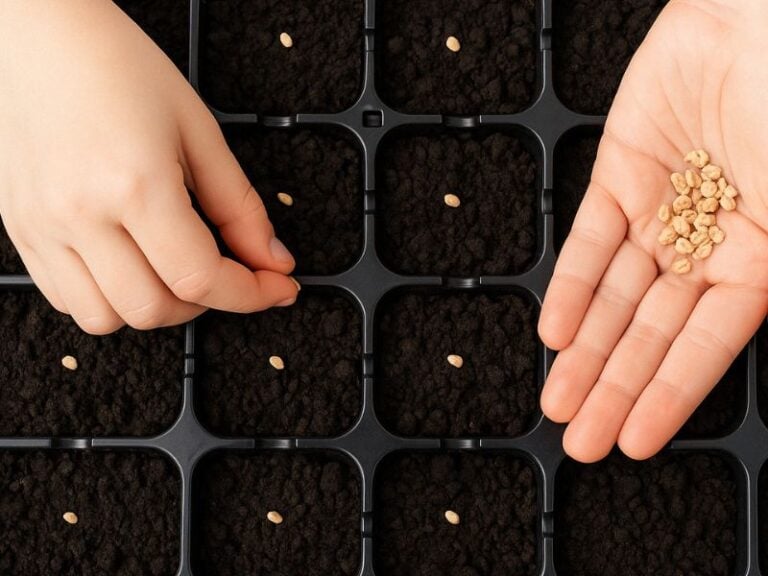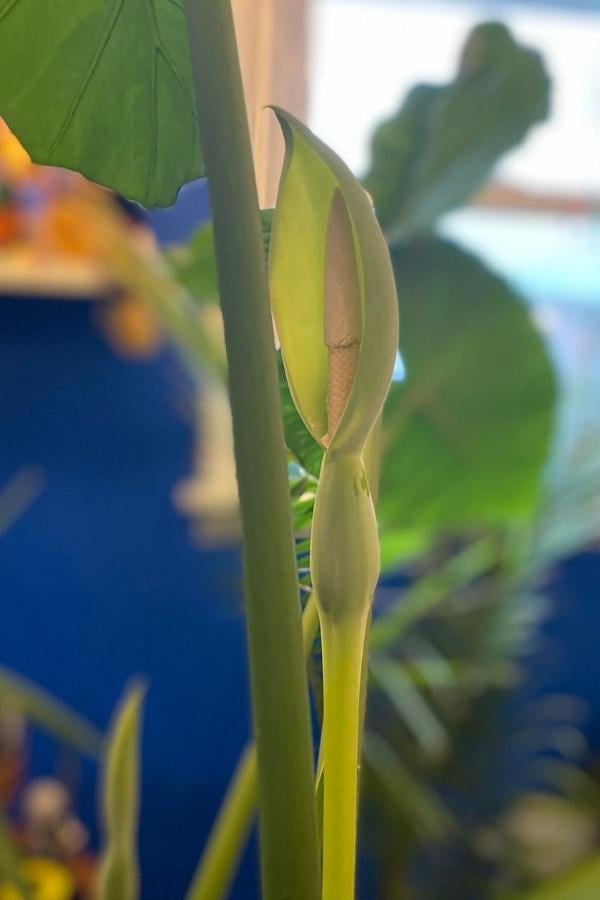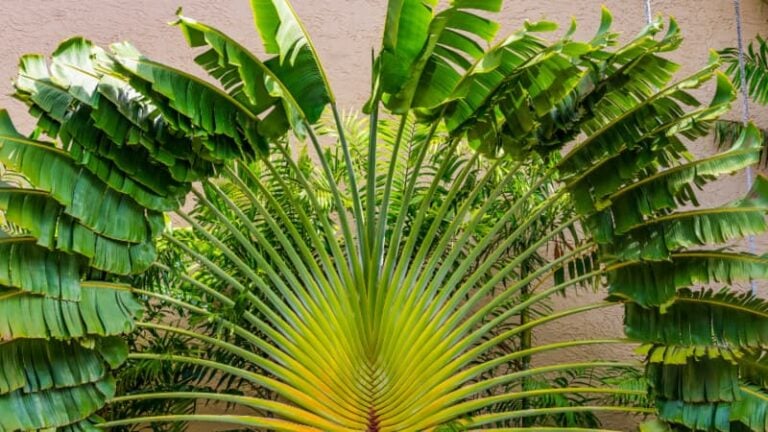Gardeners of all skill levels can benefit greatly from knowing how long it takes for a particular vegetable seed to germinate.
First, this knowledge helps you better plan when to plant seedlings and when to sow seeds. Second, it spares you a lot of unnecessary stress.
For example, does it really matter that your carrots didn’t germinate in five days if their germination period can be as long as 14 days? On the other hand, isn’t it a bit too soon to worry?
To make things easier, I’ve compiled this list of common vegetable crop sprouting times for your convenience.
Since temperature affects seed germination, I’ve also included the ideal temperatures for the first sprouts to appear.

Table 1
| Crop | Time from sowing to emergence (days) | Minimal germination temperature in open ground | Minimal germination temperature in protected ground |
| Watermelon | 10-15 | 45-50°F (7-10°C) | 59-63°F (15-17°C) |
| Eggplant | 10-14 | 46-50°F (8-10°C) | 55-57°F (13-14°C) |
| Fava beans | 4-8 | 37-41°F (3-5°C) | 37-39°F (3-4°C) |
| Peas | 4-7 | 37-41°F (3-5°C) | 39-43°F (4-6°C) |
| Melon | 7-10 | 41-45°F (5-7°C) | 59-63°F (15-17°C) |
| Zucchini, Pattypan squash | 7-8 | 39-43°F (4-6°C) | 50-54°F (10-12°C) |
| Cabbage (green/white) | 4-6 | 37-41°F (3-5°C) | 36-37°F (2-3°C) |
| Cauliflower | 4-6 | 37-41°F (3-5°C) | 36-37°F (2-3°C) |
| Sweet corn | 6-10 | 39-43°F (4-6°C) | 45-50°F (7-10°C) |
| Onion (bulb) | 14-18 | 46-57°F (8-14°C) | 36-37°F (2-3°C) |
| Leek | 20-22 | 50-54°F (10-12°C) | 54°F (12°C) |
| Carrot | 15-20 | 48-54°F (9-12°C) | 39-41°F (4-5°C) |
| Cucumber | 5-8 | 39-43°F (4-6°C) | 55-59°F (13-15°C) |
| Sweet and Hot Peppers | 14-16 | 46-59°F (8-15°C) | 46-55°F (8-13°C) |
| Radish | 4-6 | 37-41°F (3-5°C) | 34-36°F (1-2°C) |
| Daikon radish (white radish) | 5-7 | 37-41°F (3-5°C) | 34-36°F (1-2°C) |
| Lettuce | 8-10 | 39-43°F (4-6°C) | 36-37°F (2-3°C) |
| Beet | 10-16 | 45-50°F (7-10°C) | 41-43°F (5-6°C) |
| Celeriac (root celery) | – | 59-64°F (15-18°C) | 37-41°F (3-5°C) |
| Tomato | 5-8 | 39-43°F (4-6°C) | 50-52°F (10-11°C) |
| Pumpkin | 7-8 | 39-43°F (4-6°C) | 50-54°F (10-12°C) |
| Beans | 6-10 | 39-45°F (4-7°C) | 50-54°F (10-12°C) |
| Garlic | 10-17 | – | 36-41°F (2-5°C) |
| Spinach | 8-12 | – | 34-36°F (1-2°C) |
Onions grown from seedlings mature about three weeks earlier.
Table 2
| Crop | Number of days from emergence to harvest (Early) |
| Watermelon | 55-85 |
| Eggplant | 90-110 |
| Fava beans | 72-87 |
| Peas | 45-60 |
| Melon | 45-75 |
| Zucchini, Pattypan squash | 33-50 |
| Cabbage (green/white) | 45-90* |
| Cauliflower | 55-85 (25-75*) |
| Sweet corn | 60-78 |
| Onion (bulb) | 83-120** |
| Leek | 150-160 |
| Carrot | 50-80 |
| Cucumber | 40-45 |
| Sweet and Hot Peppers | 90-110*** |
| Radish | 20-30 |
| Daikon radish (white radish) | 35-65 |
| Lettuce | 30-50 |
| Beet | 60-100 |
| Celeriac (root celery) | 100-130 |
| Tomato | 65-110 |
| Pumpkin | 75-100 |
| Beans | 45-50 |
| Garlic | 80-90 |
| Spinach | 15-25 |
Notes for Table 2:
*For cabbage, the time to harvest is counted from the moment seedlings are planted in open ground.
**For onions grown from sets, reduce the above period by about 3 weeks.
***For peppers, the indicated periods refer to technical ripeness; biological ripeness occurs about 20 days later.
It’s also important not to forget that all seeds have a certain viability period after which planting them is pointless:
- Onions (leek, bunching onion, bulb onion), sorrel, rhubarb: up to 2-3 years.
- Tomatoes, peppers, eggplants, carrots, dill, parsley: up to 3-4 years.
- Cabbage, radish, turnip, beans, peas, mustard greens: up to 4-6 years.
- Zucchini, pumpkins, pattypan squash, cucumbers, melons, watermelons: up to 6-8 years.
- Beets: up to 10 years.
These timeframes are valid if the seed stock is stored correctly, primarily at optimal temperature and humidity.
Before planting any crop, be sure to calibrate your seeds. This way, you can identify empty seeds that won’t sprout. To do this, place the seeds you’ve prepared for planting into a saltwater solution for about 1.5 to 2 hours.
Any seeds that float to the surface should be discarded, while those that sink can be planted. This procedure also helps with disinfection.
If the seeds have not sprouted by the deadlines specified in Table 1, it’s highly likely they won’t germinate at all. You can give them an additional 3-4 days, but if there’s still no result, replant with seeds from a different package.
For example, in our case, in May (late spring), cucumbers didn’t sprout in the greenhouse, so we had to plant a different variety in the same spot (we opened our last remaining packet).
Remember, you’re not alone in facing these challenges—understanding germination times and seed viability can make all the difference, helping you grow stronger, more productive plants.
How To Improve Seed Germination
Sometimes the test results show good germination, but after sowing the seeds in a pot, nothing happens. Now what?
You can “encourage” seedlings to emerge by increasing the carbon dioxide around them—ideal if you have a small amount of seed. First, breathe into a plastic bag containing your seed pot.
Then, quickly tie the bag and put it back in place. Your exhaled CO2 can help stimulate the seeds, making them sprout sooner.
Heating can also speed up germination. To do this, place the seeds in a thermos filled with water at about 115-125°F (45-55°C) for at least six hours. However, avoid this method for tomato seeds.
To make seeds more resilient, harden them first. Rinse the seeds in saltwater, then treat them with a manganese or colloidal silver solution.
Afterward, put the seed pot in a plastic bag and place it in the refrigerator where you store vegetable seeds for about 10-12 hours. For a week, repeat this daily cycle: 12 hours at room temperature and 12 hours in the refrigerator.
How to Accelerate Germination
Some crops, like carrots, celery, and parsley, take a long time to germinate because their seed coats contain essential oils that slow water absorption.

Before planting these seeds, pre-treat them. I cover the seeds in blotting paper or cloth, then place them in a dish with a thin layer of water at about 115-125°F (45-55°C) for roughly 15 minutes.
During this time, most of the essential oils dissolve. Next, I rinse the cloth and seeds several times in cool water. Finally, I air-dry them until they’re no longer clinging to the cloth.
That’s it—you’re ready to sow. In this way, the seeds germinate much more quickly.






